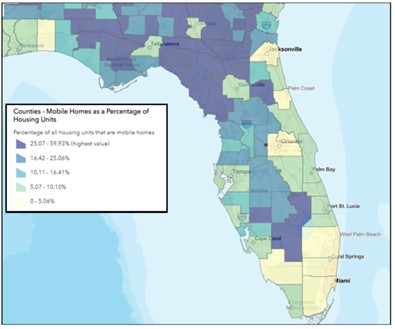In the aftermath of Hurricane Ian’s devastating impact on Florida in 2022, the need for information on resilience and mitigation against future disasters became abundantly clear. The FEMA Building Science Disaster Support Program’s Mitigation Assessment Team (MAT) began its work to quickly find mitigation successes and areas of improvement. The team dedicated a full year to thorough analysis before releasing their comprehensive report.
FEMA’s Hazard Mitigation Community Education and Outreach Group team (CEO) deployed to Florida for Hurricane Idalia around the same time the report came out. The CEO team jumped at the chance to take advantage of its findings, discovering several low to no-cost mitigation opportunities identified in the report.
The team set its path to deliver the information to the citizens of the rural Big Bend area of Florida, as a very large percentage of its population resided in mobile homes. This area topped the charts on CDC and FEMA risk profiles for the state and the nation because the combination of lightweight construction, inadequate anchoring, and lack of protective measures makes mobile homes particularly at risk for damage and destruction during natural disasters. The team decided to focus its efforts on this population to introduce the overall report.

| County | Percentage of Households in Mobile Homes |
|---|---|
| Columbia | 36% |
| Gilchrist | 53% |
| Hamilton | 42% |
| Jefferson | 39% |
| Lafayette | 45% |
| Levy | 43% |
| Madison | 40% |
| Suwannee | 52% |
| Taylor | 37% |
Map and chart depicting the mobile home population in Florida by percentage of households. Source: FEMA Resilience Analysis and Planning Tool (RAPT).
After identifying mitigation opportunities in the report, the CEO team worked with FEMA Operations who helped the CEO team by arranging meetings with emergency managers in each county. These emergency managers were eager to help and quickly became a conduit for reaching their constituents to spread the opportunity for risk reduction. They knew the area and the best ways to get the word out. They gave their input and blessing to proceed.
Some of the findings that the CEO shared were:
- The lifesaving ability of safe rooms.
- The hazards of having improper attachments, like carports, to manufactured homes.
- The benefits of elevation, especially of utility components found under manufactured homes.
- Simple practices to reduce flood damage, like using water-resistant building materials.
- The importance of properly anchoring and tying down manufactured homes.
The anchor and tie information were of particular interest to the communities. The Emergency Managers were happy to receive information about a free program to secure older mobile homes through a Gulf Coast State College grant that was funded by the Florida Division of Emergency Management Hurricane Loss Mitigation Program. The State of Florida partners with Gulf Coast State College to administer the Mobile Home Tie-Down Program, which contracts licensed mobile home installers to retrofit additional tie-downs to homes installed before 1999. The program aims to enhance wind resistance in mobile homes, mitigating potential damage from windstorms, tornadoes, or hurricanes within funding and physical constraints.
These fruitful contacts with the Emergency Managers also opened the door to other discussions about needs and concerns where FEMA and its Federal and State partners might be available to help fill the gaps. Within days of the first community contacts, the first calls were coming in. One example was sparked by Taylor County realtors who had seen the information on the Taylor County website and shared it with their clients.
Tracking the success of this program poses a challenge, yet the CEO team is diligently endeavoring to monitor its progress. The team has been invited to special events and additional opportunities are in the works. Each person who receives the message is a potential force multiplier. The true extent of the CEO’s work will never be known.
Mitigation not only preserves financial resources but also serves as a crucial component for personal safety. Research indicates that, on average, every dollar allocated to mitigation efforts can prevent up to eleven dollars in damage loss. While monetary savings are significant, it's important to recognize that the value of human life is immeasurable. In the Big Bend area of Florida, the combined efforts of the CEO and the Mitigation Assessment Team may have not only preserved finances but also safeguarded precious lives.

